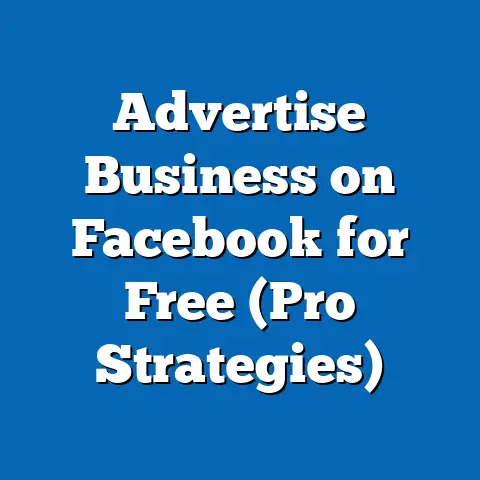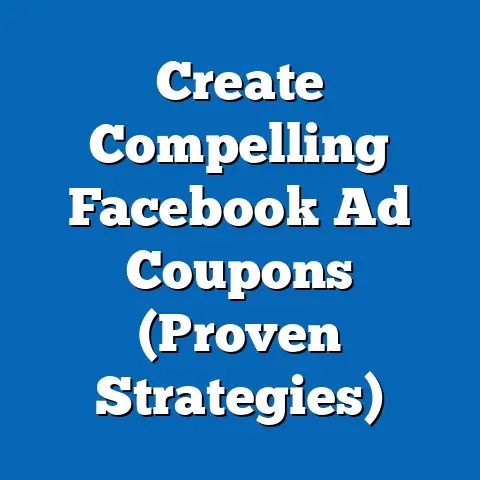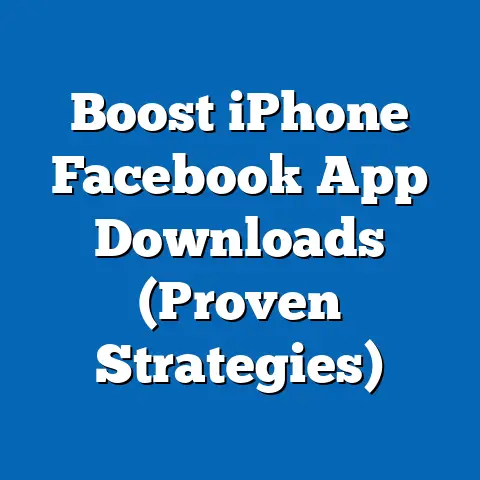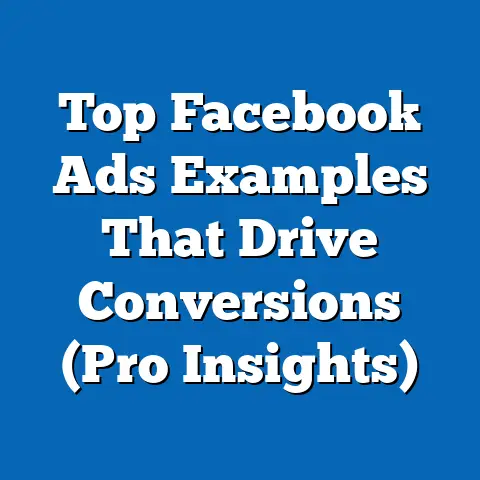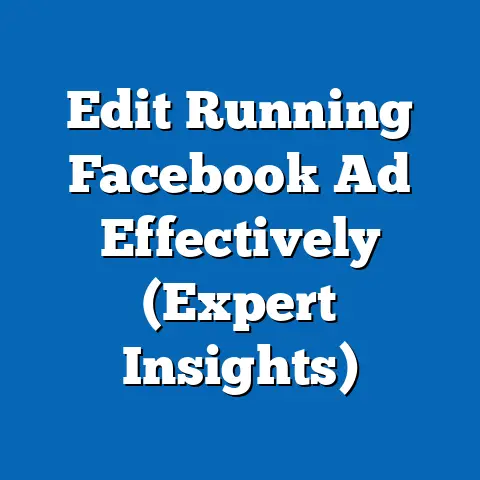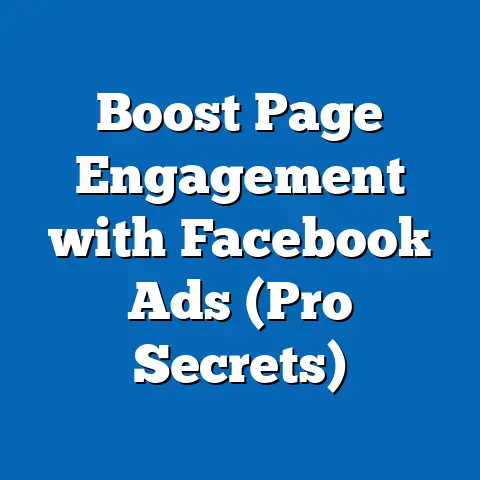Eliminate Facebook Ads (Ultimate Strategy Guide)
Eliminating Facebook Ads: The Ultimate Strategy Guide
The reliance on Facebook Ads has grown over the years, but with the increasing concerns over privacy, constant algorithm changes, and the ever-evolving preferences of users, many businesses are seeking alternative advertising strategies. The truth is, while Facebook Ads can be a powerful tool, they’re not the only game in town. This guide aims to provide you with actionable strategies to reduce your dependence on Facebook Ads and explore more diverse and sustainable advertising methods.
Understanding the Limitations of Facebook Ads
As someone who’s been in the trenches of digital marketing, I’ve seen the ups and downs of relying heavily on a single platform. Facebook Ads, while offering targeted reach, come with their own set of challenges that can significantly impact your ROI and overall marketing strategy.
High Competition and Rising Costs
The first and most glaring limitation is the high level of competition. With millions of businesses vying for the same audience, the cost per click (CPC) has been steadily rising. This means you’re paying more for the same level of exposure, eating into your profit margins. I remember when a $5 daily budget could get you significant traction; now, it barely scratches the surface.
Ad Content Restrictions and Account Bans
Another major pain point is the strict and sometimes arbitrary ad content restrictions. Facebook’s policies can be a minefield, and even seemingly innocuous ads can get flagged, leading to account bans. I’ve personally had ads rejected for reasons that were unclear, leading to wasted time and resources trying to decipher the rules. This unpredictability can be frustrating and disruptive to your campaigns.
Limited Organic Reach
Perhaps one of the most significant issues is the decline in organic reach. Facebook’s algorithm prioritizes content from friends and family, making it increasingly difficult for businesses to reach their audience organically. This forces businesses to rely on paid ads just to be seen, creating a dependency that can be unsustainable in the long run. I’ve noticed that content that used to get significant organic engagement now barely makes a ripple without a paid boost.
The increasing costs, restrictive policies, and declining organic reach have led many businesses to seek alternative advertising avenues to mitigate these limitations. It’s no longer about simply throwing money at Facebook Ads and hoping for the best. It’s about strategic diversification and finding channels that offer better ROI and more control.
Key Takeaway: Recognize the limitations of Facebook Ads and understand that diversifying your advertising strategy is essential for long-term success.
Identifying Your Target Audience Beyond Facebook
Before you can effectively diversify your advertising channels, you need to deeply understand your target audience and their behaviors outside of Facebook. This goes beyond basic demographics and delves into their interests, preferences, and the platforms they frequent.
Gathering Audience Insights
Understanding your audience is the bedrock of any successful marketing strategy. It means knowing where they spend their time online, what kind of content resonates with them, and what problems they’re trying to solve.
- Surveys: Direct feedback is invaluable. Tools like SurveyMonkey or Google Forms can help you gather insights directly from your audience. I once ran a survey that revealed my target audience was more active on LinkedIn than I had initially thought, leading me to shift some of my advertising efforts.
- Analytics: Dive deep into your website and social media analytics. Google Analytics can provide a wealth of information about your website visitors, including their demographics, interests, and behavior. Facebook Analytics (now part of Meta Business Suite) can offer insights into your Facebook audience, but remember, we’re trying to look beyond Facebook here.
- Market Research: Stay updated on industry trends and market research reports. These reports can provide valuable insights into consumer behavior and emerging trends.
- Social Listening: Use social listening tools like Brandwatch or Mention to monitor conversations about your brand, your industry, and your competitors. This can help you identify where your audience is talking about you and what they’re saying.
Exploring Alternative Platforms
Once you have a better understanding of your audience, you can start exploring alternative platforms where they may be more active.
- Instagram: If your target audience is visually oriented, Instagram can be a great alternative. With its focus on images and videos, Instagram is perfect for showcasing your products or services in an engaging way.
- TikTok: For younger audiences, TikTok is a must-consider. Its short-form video format is highly engaging and can be a great way to reach a new audience.
- LinkedIn: If you’re targeting professionals, LinkedIn is the platform to be on. It’s perfect for B2B marketing and reaching decision-makers.
- Twitter: Twitter is great for real-time updates, news, and engaging in conversations with your audience.
- Pinterest: If your business is visually driven (e.g., fashion, home decor, food), Pinterest can be a powerful platform.
The key here is to adopt a multi-channel approach. Don’t put all your eggs in one basket. By diversifying your presence across multiple platforms, you can reach a wider audience and reduce your reliance on any single channel.
Key Takeaway: Deeply understand your target audience and identify the platforms where they are most active outside of Facebook. This will inform your diversification strategy.
Diversifying Advertising Channels
Now that you have a solid understanding of your target audience and the platforms they frequent, it’s time to explore alternative advertising channels. This is where you can get creative and find strategies that align with your brand and business goals.
Google Ads: Search Intent and Remarketing
Google Ads is a powerful alternative to Facebook Ads, primarily because it allows you to target users based on their search intent. Unlike Facebook, where you’re interrupting users with ads while they’re browsing, Google Ads allows you to reach users who are actively searching for your products or services.
- Search Ads: These ads appear at the top and bottom of Google’s search results pages. They’re highly targeted and can be a great way to drive traffic to your website.
- Display Ads: These ads appear on websites across the Google Display Network. They’re less targeted than search ads but can be a great way to build brand awareness.
- Remarketing Ads: These ads target users who have previously visited your website. They’re highly effective because they target users who are already familiar with your brand.
I’ve seen businesses achieve significant ROI by focusing on Google Ads, particularly through strategic keyword targeting and compelling ad copy. The ability to capture users at the moment they’re actively searching for a solution is a game-changer.
Content Marketing: Attracting Organic Traffic
Content marketing is a long-term strategy that involves creating valuable, informative, and engaging content to attract and retain your target audience. This can include blog posts, articles, videos, infographics, and more.
- SEO Optimization: Optimize your content for search engines to improve its visibility. This includes using relevant keywords, creating high-quality content, and building backlinks.
- Valuable Content: Create content that solves your audience’s problems, answers their questions, and provides value. This will help you build trust and credibility.
- Consistent Publishing: Regularly publish new content to keep your audience engaged and attract new visitors to your website.
Content marketing is an investment, but it can pay off handsomely in the long run. By creating valuable content, you can attract organic traffic, build brand authority, and establish yourself as a thought leader in your industry. I’ve seen businesses transform their online presence simply by committing to a consistent content strategy.
Email Marketing: Driving Conversions
Email marketing is a direct and personal way to connect with your audience. By building a targeted email list, you can send out newsletters, promotions, and other valuable content directly to your subscribers’ inboxes.
- Segmentation: Segment your email list based on demographics, interests, and behavior. This will allow you to send more targeted and relevant emails.
- Personalization: Personalize your emails to make them more engaging and relevant. This includes using the subscriber’s name, referencing their past purchases, and tailoring the content to their interests.
- Automation: Automate your email marketing to save time and improve efficiency. This includes setting up welcome emails, abandoned cart emails, and other automated sequences.
Email marketing can be a highly effective way to drive conversions without the need for Facebook Ads. I’ve seen businesses achieve impressive ROI by focusing on building and nurturing their email list.
Influencer Marketing: Authentic Reach
Influencer marketing involves partnering with influencers in your niche to reach new audiences authentically. Influencers have built a following of engaged fans who trust their recommendations.
- Relevance: Choose influencers who are relevant to your brand and target audience.
- Authenticity: Look for influencers who are authentic and genuine. Their audience should trust their recommendations.
- Engagement: Choose influencers who have high engagement rates. This means their audience is actively interacting with their content.
Influencer marketing can be a great way to reach a new audience and build brand awareness. I’ve seen businesses achieve impressive results by partnering with the right influencers.
Key Takeaway: Explore and implement a diverse range of advertising channels beyond Facebook Ads, including Google Ads, content marketing, email marketing, and influencer marketing.
Building an Organic Presence
While paid advertising can drive immediate results, building a strong organic presence is essential for long-term sustainability. This involves strengthening your brand’s presence on social media and optimizing your website for search engines.
Social Media Strategy
- Platform Selection: Focus on the platforms where your target audience is most active. Don’t try to be everywhere at once.
- Content Strategy: Create content that is engaging, informative, and relevant to your audience. This includes images, videos, articles, and more.
- Engagement: Engage with your audience by responding to comments, answering questions, and participating in conversations.
- Consistency: Regularly post new content to keep your audience engaged and attract new followers.
SEO Strategies
- Keyword Research: Identify the keywords that your target audience is using to search for your products or services.
- On-Page Optimization: Optimize your website’s content, title tags, and meta descriptions for your target keywords.
- Off-Page Optimization: Build backlinks from other websites to improve your website’s authority.
- Technical SEO: Ensure your website is mobile-friendly, fast-loading, and easy to navigate.
Community Engagement
- Forums: Participate in online forums and communities related to your niche.
- Groups: Join relevant Facebook groups and engage in conversations.
- Events: Attend industry events and conferences to network and build relationships.
Key Takeaway: Invest in building a strong organic presence through social media, SEO, and community engagement to drive long-term, sustainable growth.
Measuring Success and Adjusting Strategies
No matter what advertising strategies you choose, it’s essential to track your results and make adjustments as needed. This involves using analytics to measure the effectiveness of your campaigns and continuously refining your approach.
Analytics Tools
- Google Analytics: Track website traffic, user behavior, and conversions.
- Social Media Analytics: Monitor engagement, reach, and follower growth on social media platforms.
- Email Marketing Analytics: Track open rates, click-through rates, and conversions from email campaigns.
- CRM: Customer Relationship Management system that tracks interactions with your business, and is used to analyze and improve customer relationships.
Key Metrics
- Website Traffic: Measure the number of visitors to your website.
- Conversion Rate: Track the percentage of visitors who complete a desired action, such as making a purchase or filling out a form.
- Engagement Rate: Monitor the level of interaction with your content on social media and other platforms.
- ROI: Calculate the return on investment for each advertising channel.
Data-Driven Approach
- A/B Testing: Experiment with different ad creatives, landing pages, and email subject lines to see what works best.
- Continuous Improvement: Regularly review your analytics and make adjustments to your strategies based on the data.
Key Takeaway: Implement robust analytics tracking to measure the effectiveness of your advertising strategies and continuously refine your approach based on data.
Conclusion
As we’ve explored, there are numerous effective strategies for businesses to eliminate their reliance on Facebook Ads. By understanding the limitations of the platform, identifying your target audience beyond Facebook, diversifying your advertising channels, building an organic presence, and measuring your success, you can create a more sustainable and profitable advertising strategy.
It’s time to take action. Assess your current advertising strategies, explore new avenues that align with your business goals, and embrace the potential for growth and success through innovative advertising strategies, free from the limitations of Facebook Ads.
The digital landscape is vast and full of opportunities. By diversifying your approach, you can not only reduce your dependence on a single platform but also reach a wider audience, build a stronger brand, and achieve greater success. Remember, the key is to be strategic, adaptable, and always willing to learn and evolve.

